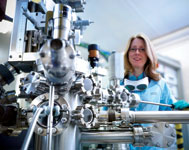Graphene one step closer to replacing silicon
17 September 2014
News
A team of scientists, led by Professor Philip Hofmann from Aarhus University in Denmark, set out to determine specifically whether bilayer graphene could be used as a semiconductor. Their results suggest that it could replace silicon transistors in electronic circuits, and serve as the basis for chips that are faster and consume less energy than at present.
Graphene is pure carbon in the form of a very thin, almost transparent, sheet just one atom thick. It is widely hailed as a ‘miracle material’ because of its remarkable strength and efficiency in conducting heat and electricity. In its current form, graphene is not suitable for transistors, which are the foundation of all modern electronics. For a transistor to be technologically viable, it must be able to ‘switch off’ so that only a small electric current flows through its gate when in a standby state. Since graphene does not have a band gap, it cannot switch off.
STFC’s Dr Emma Springate, one of the research team, with the Artemis laser. (Credit: Monty Rakusen Photography).
The latest research used a new material – bilayer graphene – in which two layers of graphene are placed one on top of the other, leaving a small band gap to encourage the transfer of energy between layers. Using STFC’s Artemis laser, which is based at the Rutherford Appleton Laboratory in Oxfordshire, the researchers fired ultra-short pump laser pulses at the bilayer graphene sample, boosting electrons into the conduction band.
A second short, extreme ultraviolet wavelength pulse then ejected electrons from the sample. These were collected and analysed to provide a snapshot of the energies and movement of the electrons.
“We took a series of these measurements, varying the time delay between the infrared laser pump and extreme ultraviolet probe, and sequenced them into a movie,“ said STFC’s Dr Cephise Cacho, one of the research team. “To see how the fast-moving electrons behave, each frame of the movie has to be separated by just a fraction of a billionth of a second.”
Professor Hofmann added that, “What we’ve shown with this research is that our sample behaves as a semiconductor, and isn’t short-circuited by defects,” alluding to the fact that there can be imperfections in bilayer graphene as the layers sometimes become misaligned.
The research team asserts that the results of this research, in which the graphene showed no defects, suggest that further technological effort should be carried out to minimise imperfections. Once this is done, there is a chance that the switch-off performance of bilayer graphene can be boosted enough to challenge silicon-based devices.
Further reading:
Electronic News Digest
News
A brief synopsis of current global news relating to the electronic engineering fields with regards to company finances, general company news, and engineering technologies.
Read more...
4000 A containerised DB for power project
News
Power Process Systems has successfully completed the design, fabrication, and commissioning of a 4000 A containerised distribution board for a wind/PV solar hybrid renewable energy project.
Read more...
Datacentrix Industrial Indaba 2025
News
Datacentrix recently hosted its inaugural Industrial Indaba 2025, where industry leaders explored how digitalisation, resilience, security and compliance are shaping the future of sustainable industrial operations in Africa.
Read more...
RS brings solar light to 150 000 people
RS South Africa
News
The company’s three-year partnership with SolarAid aims to raise £1 million through corporate donations, matched funding, product contributions, and fundraising to accelerate access to safe, sustainable energy.
Read more...
Microchip and AVIVA Links collaboration
Altron Arrow
News
Microchip and AVIVA Links have achieved groundbreaking ASA-ML interoperability, accelerating the shift to open standards for automotive connectivity.
Read more...
World’s leading supplier of grid automation products
News
Hitachi Energy was recognised as the global market share leader in grid automation for electric power transmission and distribution utilities by ARC Advisory Group.
Read more...
Vivashan Muthan appointed as head of export sales and operations at RS South Africa
RS South Africa
News
With a career spanning engineering, business development, and sales leadership across sub-Saharan Africa, Vivashan Muthan brings a wealth of expertise to his new role as head of export sales and operations.
Read more...
Google equips university students across Africa with free access to advanced AI tools
News
A 12-month Google AI Pro plan has been launched for students in Ghana, Kenya, Nigeria, Rwanda, South Africa, and Zimbabwe to build foundational AI skills.
Read more...
Africa’s space economy projected to be worth $22,6 billion in 2026
News
South Africa is gearing up to be at the forefront of the growth in the space industry, creating thousands of jobs, driving innovation, and boosting the national economy.
Read more...
Distribution partnership with MacDermid Alpha
Testerion
News
MacDermid Alpha Electronics Solutions India Private Limited has announced that as of 01 September 2025 Testerion will be the sole importer and distributor of their products to the South African market.
Read more...


